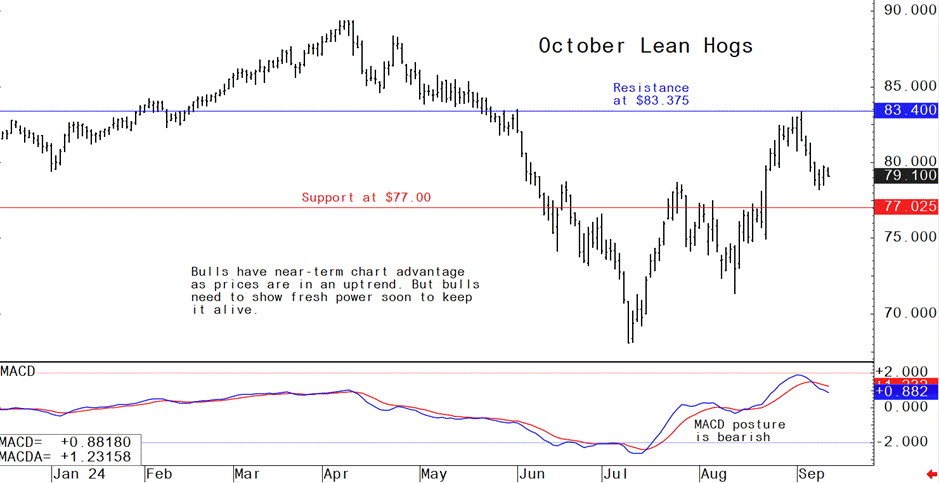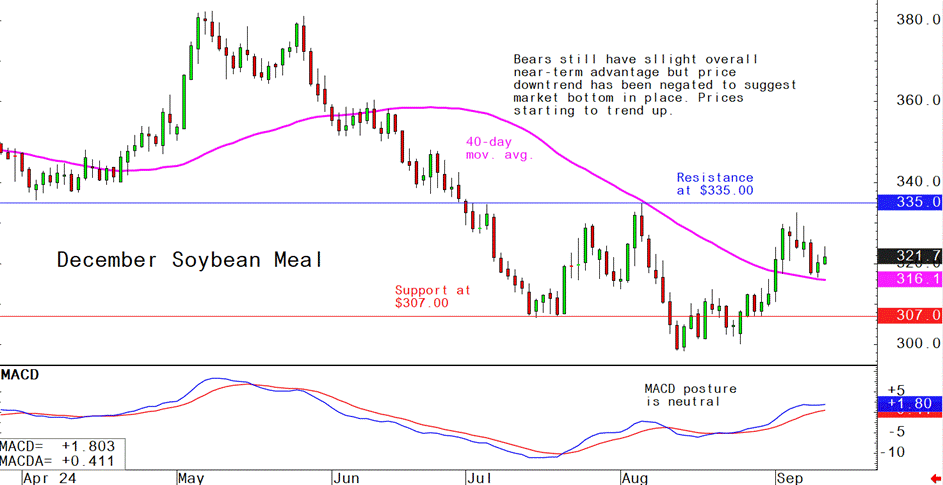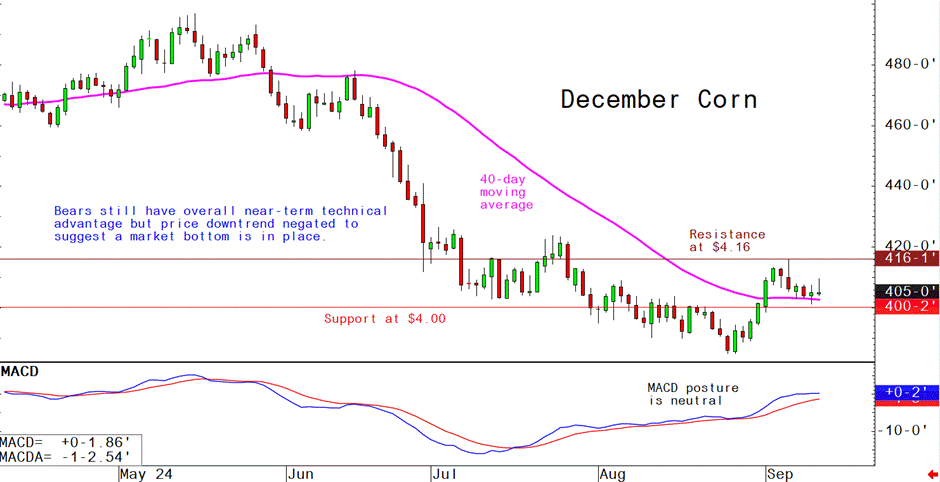



Pig outlook: Lean hog futures bulls fade a bit
Livestock analyst Jim Wyckoff reports on global pig newsOctober lean hog futures prices have backed down from the September high on profit-taking pressure from the speculators. Prices are still in an uptrend on the daily bar chart, but bulls need to show fresh power soon to keep it alive. Deteriorating cash hog fundamentals could limit the upside in futures. The latest CME lean hog index is down another 10 cents, to $85.46, as of Sept. 10. That’s the lowest level since April 2. Pork cutout dropped $1.89 to $92.91 on Wednesday, the lowest mark since March 21. Some modest strength in hog futures could occur as traders narrow discounts to the cash index. On the positive side, US retailers appear to be stocking up for pork features in October, which is National Pork Month. Movement surpassed 400 loads on Tuesday at 434.32 loads, the highest total in some time.
Latest USDA and other news regarding the global pork industry
Weekly USDA US pork export sales
Pork: Net US sales of 29,700 MT for 2024 were up 43 percent from the previous week and 15 percent from the prior 4-week average. Increases were primarily for Mexico (14,200 MT, including decreases of 200 MT), Japan (4,300 MT), Colombia (2,400 MT, including decreases of 100 MT), China (2,000 MT, including decreases of 200 MT), and Canada (1,400 MT, including decreases of 700 MT). Total net sales of 100 MT for 2025 were for the Dominican Republic. Exports of 25,700 MT were down 8 percent from the previous week and 10 percent from the prior 4-week average. The destinations were primarily to Mexico (10,700 MT), Japan (3,800 MT), China (3,200 MT), Colombia (1,700 MT), and South Korea (1,600 MT).
Chinese meat imports have declined significantly compared to previous years
Through the first eight months of 2024, China imported 4.40 million metric tons (MMT) of meat products, down 13.9% from the same period in 2023. In August 2024, China imported 565,000 MT of meat, which was 9.9% lower than August 2023. Beef imports have been particularly affected, with volumes down 27% year-over-year in July 2024.
Several factors are contributing to lower Chinese meat imports in 2024:
Economic headwinds are impacting consumption of both pork and beef.
- China has ample domestic meat supplies after building up stocks in 2023.
- Pork production in China remains high, reducing import needs.
- Chinese consumers are seeking cheaper protein options due to economic slowdown.
- Import bans on some U.S. meat facilities have restricted supply.
Pork
- Pork imports may grow marginally to offset a forecasted 3% decline in domestic production.
- China's pork output fell 0.4% year-over-year in Q1 2024, the first quarterly decline in nearly 4 years.
Beef
- Beef imports are expected to decline in 2024 due to high year-end inventory and flat demand.
- China's share of global beef imports is forecast to be 5% below 2023 levels.
Poultry
- Poultry meat imports accounted for $282 million in July 2024, resulting in a negative trade balance.
Impact on global trade
- The U.S. has seen a fall in meat exports as China scales back imports.
- Brazil has increased beef exports to China, up 10.2% in the first half of 2024.
- Australia has shifted more beef exports to the U.S. and Japan as Chinese demand weakens.
Bottom line: While there have been some month-to-month fluctuations, overall Chinese meat imports remain well below 2023 levels as domestic production remains high and economic factors dampen demand. This has led to shifts in global meat trade flows, with exporters like the U.S., Brazil and Australia adjusting to changing Chinese import patterns.
Highlights of US pork group virtual briefing on key challenges.
Bottom line issues for National Pork Producers Council:
Brian Humphreys, CEO of the National Pork Producers Council, said: We’re here to find solutions, not just discuss challenges. We need a 2024 Farm Bill — not an extension. We need a legislative fix to California's Prop 12, resolutions to the labor shortage, and an active trade agenda. NPPC says moving a new farm bill this year with language restricting state animal welfare rules is the group’s top priority.
- Need for new farm bill: “With all the stress on farmers now, it's important that we get this moved now while we've got the opportunity," Duane Stateler, president-elect of NPPC, said in the virtual briefing. "If the farm bill goes into next year, it starts all over. We have many good things in this farm bill which makes it imperative we get it done in 2024," Lori Stevermer, NPPC president, said in the briefing.
- Proposition 12: The 2024 Farm Bill is a golden opportunity to address a top issue for pork producers across the country – California Prop 12," Stevermer said. Proposition 12, a 2018 California ballot initiative, prohibits the sale of uncooked whole pork meat not produced according to the state’s arbitrary housing dimensions. The initiative places the cost and compliance burden on pork producers, who are nearly all located outside of California, and puts the industry at risk of significant consolidation, NPPC argues. The Supreme Court of the United States said this is an issue for Congress to solve, and NPPC has been urging passage of the farm bill which includes a federal solution to Prop 12. "We cannot continue down a path of unscientific rules and regulations," Humphreys said on the call. "It's not a question about what has happened, but it's a question of how do we move forward and protect the U.S. from this patchwork of regulations? We appreciate the bipartisan solution in the farm bill to make that happen." Stevermer said Prop 12 impacts extend beyond producers as it has also resulted in higher prices for consumers. “Pork prices are up on average 20% since Prop 12 went into place, and the supply is down about 20% so that's not good for consumers, and it's not good for farmers either,” she said.
- Labor issues remain a concern, with the group presses for improvements to the TN skilled guestworker visa program. NPPC said policy concerns include addressing the persistent ag labor shortage and contending with inflationary impacts on production costs. While ag labor discussions often focus on the H-2A ag guestworker program for low-skilled farm laborers, pork industry officials said they also face difficulty using the TN visa program, which allows businesses to procure skilled workers from Mexico and Canada. The State Department recently made changes to the program aimed at streamlining it, but NPPC officials said they have effectively closed off the ability to use TN visas by the pork sector. “It just seems like every day there's less and less TNs approved,” said NPPC Vice President Rob Brenneman. He explained that the program has become more important in helping producers secure the workers skilled in utilizing new production technologies that are difficult to find in the domestic labor market. “I think it's absolutely absurd that we just keep getting TNs denied … we've been to the State Department, and we've been to the White House and had conversations, and it just seems like they're doing everything in their power to do the opposite of what we're asking because nothing's changed,” Brenneman said.
- Cost of production. NPPC officials said that besides labor shortages, producers also continue to grapple with higher production costs, though the growth in costs has slowed in areas like feed. Other fixed costs like transport, labor and utility bills mean overall production costs remain roughly 25% higher than they were three years ago, officials stressed. “While we're getting a little relief on the feed side, we're still seeing elevated costs of production,” said NPPC board member Scott Hays.
- CAFOs: Officials were asked to weigh in on a lawsuit from environmental groups seeking to compel EPA to act on their petition seeking an overhaul of how the agency regulates concentrated animal feeding operations (CAFOs). NPPC and other livestock and poultry interests are backing EPA’s decision to deny the petition, as the question heads to federal court later this week. Calling the CAFO lawsuit “an attack on ag by activist groups,” NPPC’s Statler said, noting EPA was right to deny the petition. “What they've asked EPA to do was illegal.” Stateler praised EPA for engaging with stakeholders including NPPC on the issue to gather information before considering any additional action. “They decided to take a look and look at the facts, and they turned it over to explore the issues that are really involving all CAFOs and the ag groups, including NPPC, are participating in that process,” he added, saying the group looks forward to finding a solution that works for all involved.
- Trade policy: NPPC continues to urge new trade agreements, but acknowledges new FTAs are unlikely. “We know that's not how things are being done — in the manner that maybe they were, you know, 10 or 15 years ago,” Stevermer said regarding new FTAs, but she added that such agreements are not an end all be all for trade. Trade programs like the Generalized System of Preferences (GSP) and African Growth and Opportunity Act (AGOA), both pending renewal, are also important for the sector, she said.
The next week’s likely high-low price trading ranges:
October lean hog futures--$76.00 to 83.375 and with a sideways bias
December soybean meal futures--$308.00 to $335.00, and with a sideways bias
December corn futures--$4.00 to $4.25 and a sideways-higher bias
Latest analytical daily charts lean hog, soybean meal and corn futures










